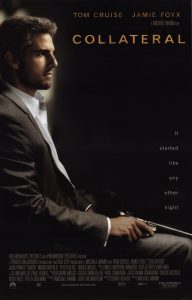
The Psychology of Michael Mann’s Cartel Assassin
Title: Collateral
Directed by: Michael Mann
Produced by: Michael Mann, Julie Richardson
Production Companies: Paramount Pictures, DreamWorks Pictures
Country: USA
Year: 2004
Los Angeles cab driver Max Durocher (Jamie Foxx) is having a bad night: His last fare for the evening, a silver-haired, silver-suited man named Vincent (Tom Cruise) is a contract killer in need of transportation. Between sunset and sunrise, Max is hired (coerced) into driving Vincent to five different locations where he aims to kill key figures in a trial against a major drug trafficking organization. Along the way, Max and Vincent learn more about one another, developing a rapport that alternates between hostile and friendly – Vincent’s violent skills and unique personal philosophy form the central psychological atmosphere of the film that asks us to consider the place of the innocent bystander in the violent narrative of international drug-trafficking.
Collateral puts a central focus on the figure of the assassin. Other narco-dramas include low-level thugs and hitmen, but Vincent brings a unique level of professionalization to the violence of drug cartels. Where the violence of Narcos is random and animalistic, the violence of Collateral is controlled, refined, and some might say elegant – without sacrificing any of the brutality of those other shows. Collateral presents an opportunity to examine the cultural understanding of the act of assassination and the figure of the assassin: There seems to be some delineation between simple murder and assassination, and the figure of the armed thug and assassin, and Collateral uses its violence to interrogate where these lines are drawn and how they are aestheticized. Furthermore, Vincent is unique among cartel hitmen: He is a white man, hired outside of the ranks of the cartel itself. Vincent is an outsider to both the cartel and his hunting grounds – an intruder into the urban space of Los Angeles. Collateral’s portrayal of violence by and upon certain groups of people is another element critical to understanding the film’s treatment of the assassin and how this treatment manifests itself in the cultural consciousness.
Collateral is an exemplar of the neo-noir[1. Ostberg, R.. “neo-noir.” Encyclopedia Britannica, November 5 2022. https://www.britannica.com/art/neo-noir.] genre of films that grew intensely popular in the mid-to-late 2000s. These films take place in urban environments cloaked in shadow, choosing to moodily meditate on criminality and nihilism with bleak, violent plotlines and endings. Understanding neo-noir is fundamental to understanding how modern film portrays criminality, violence, and urban society in the contemporary world. Modern narco-dramas owe many of their aesthetic hallmarks to the neo-noir genre, including gritty depictions of crime, violence, and drugs that coalesce together to form a grim but effective picture of a society that’s failed to eliminate these problems from itself – putting a mirror to itself and the effect of these phenomena on ordinary people. Los Angeles, where Collateral takes place, is the perfect neo-noir city because as Vincent says in Collateral, “17 million people. This was a country, it’d be the fifth biggest economy in the world and nobody knows each other.” (15:32) This claustrophobic anonymity breeds the gritty violence the film deploys both to shock and excite and show how crime thrives in the darkness where the oblivious populace doesn’t dare or care to look.
Biography
Conner Dejecacion is a second-year Northwestern student studying Journalism, English Literature, and History. He currently contributes gaming editorial content to DBLTAP and AppTrigger, and is an Assistant Managing Editor at North by Northwestern, overseeing the Entertainment and Graphics sections. He frequently writes about games, films, and other forms of entertainment.